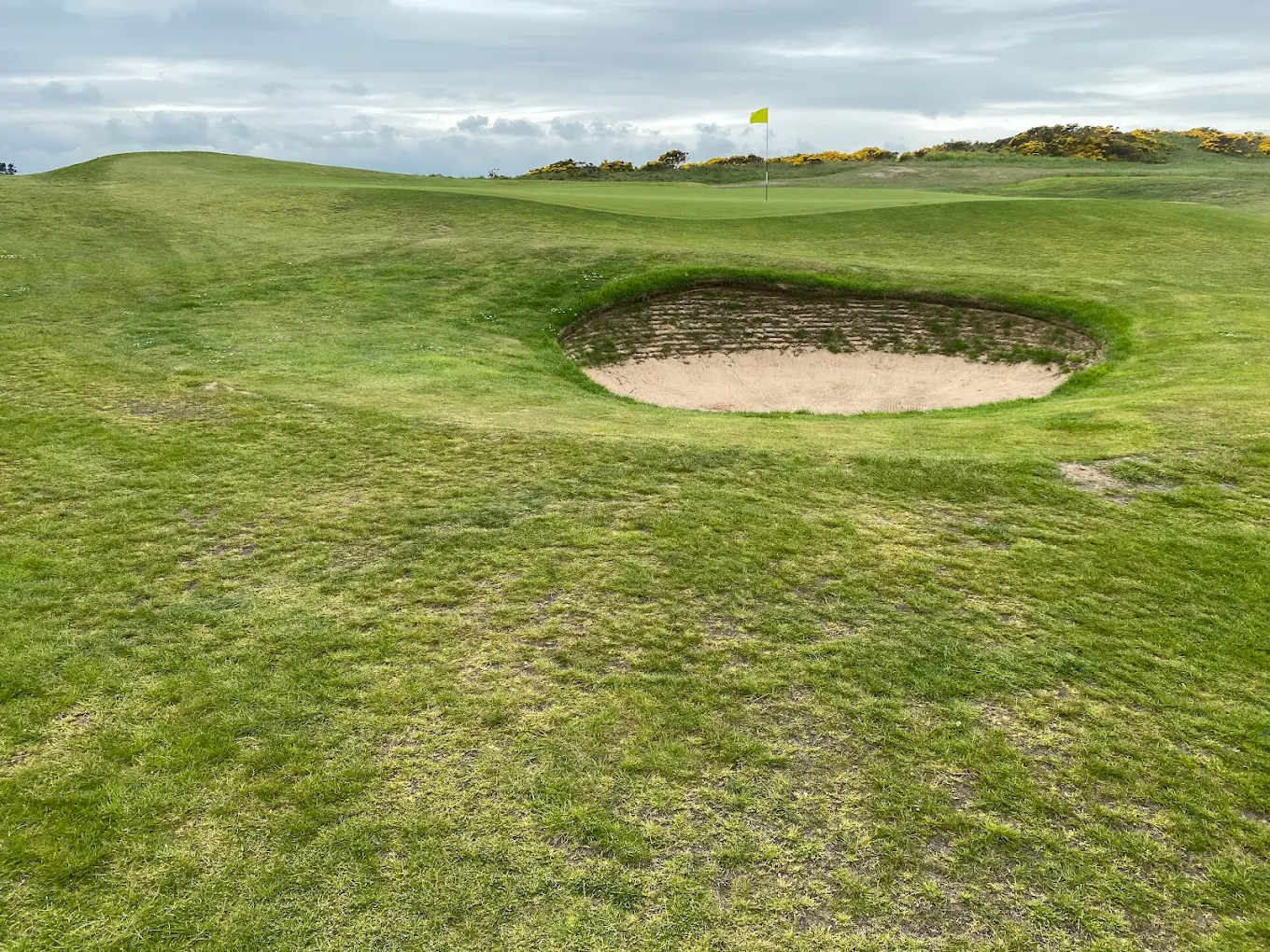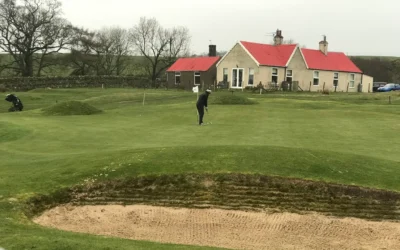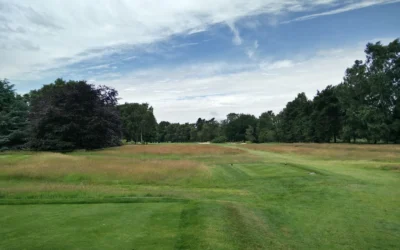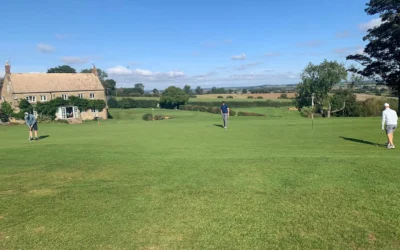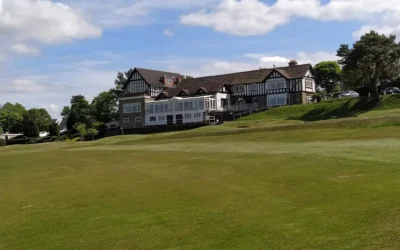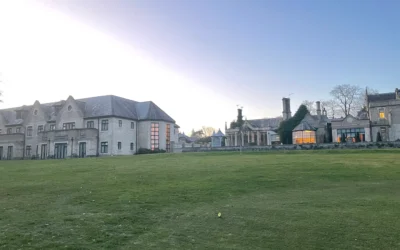Dunstanburgh Castle Golf Course
Dunstanburgh Castle Golf Course (Embleton, Northumberland, England)
Perched on the rugged Northumberland coast, Dunstanburgh Castle Golf Course is a testament to the timeless allure of links golf. Imagine teeing off with the wind-whipped North Sea stretching endlessly before you, while the ancient ruins of the 14th-century Dunstanburgh Castle loom majestically in the distance. Designed by legendary architect James Braid and refined over decades, this course challenges players with its strategic layout while rewarding them with some of the most breathtaking views in golf.
Whether you’re navigating wind-swept fairways or soaking in the coastal scenery, Dunstanburgh offers a round that blends history, nature, and the spirit of the game. For golfers seeking a true links experience in a setting that feels both ancient and exhilarating, this course is a must-visit destination.
Key Details
- Location: Embleton, Northumberland, England
- Length: 6,287 yards (from back tees)
- Par: 70
- Designers: James Braid (1920), with major redesigns by William Sutherland in 1987
- Established: 1900 (initial 9-hole course), extended to 18 holes by 1936
- Notable Events: A historic course with a rich legacy, known for its challenging layout and scenic beauty
History and Significance
Founding and Early Years
Dunstanburgh Castle Golf Course has a storied past that began in 1900, when a modest 9-hole course was established on the links land adjacent to Embleton Bay. This early layout captured the essence of coastal golf, with natural dunes and sea breezes shaping play. In 1919, shipping magnate Sir Arthur Munro Sutherland acquired the estate, recognizing its potential as a premier golfing destination.
He promptly enlisted James Braid, a five-time Open Championship winner and renowned architect, to enhance the course. Braid’s 1920 modifications—lengthening four holes, shortening four others, and designing a new hole—set the stage for a classic links experience.
Evolution and Redesigns
The course evolved gradually, with three additional holes added by 1929, another three by 1931, and the final three by 1936, completing its 18-hole configuration. In 1961, Sir Ivan Sutherland, Sir Arthur’s son, gifted the estate to the National Trust, ensuring the preservation of both the castle and its surrounding landscape, including the golf course, while retaining the lease for golf operations.
The most significant transformation occurred in 1987, when William Sutherland, Sir Arthur’s great-nephew, collaborated with architect Jonathan Gaunt to redesign ten holes. This update brought the course to its current 6,287 yards and par 70, balancing modern playability with its historic character.
Historical Events
While Dunstanburgh has not hosted major professional tournaments, its legacy is rooted in its enduring appeal to local and visiting golfers. The course has been a venue for regional competitions and society outings, with events like the Faldo Junior Tour and NCG Top 100s Tour scheduled for 2025, highlighting its growing recognition. Its historical ties to the Sutherland family and the National Trust add a layer of cultural significance, making every round a journey through golfing heritage.
Cultural Impact
Dunstanburgh Castle Golf Course is celebrated for its scenic beauty and challenging layout, often described as one of Northumberland’s finest courses. Golfers praise its friendly atmosphere, with reviews noting its pristine condition and value for money. The course’s setting in an Area of Outstanding Natural Beauty, coupled with its proximity to Dunstanburgh Castle, elevates its status as a cultural and recreational landmark. As one golfer remarked, “Dunstanburgh Castle GC is arguably the best golf course in the county. It’s also one of the most scenic and enjoyable”.
Course Features
General Layout and Terrain
Dunstanburgh Castle Golf Course is a quintessential links layout, stretching along a narrow strip of land between Dunstanburgh Castle and Embleton Bay. Its 18 holes, measuring 6,287 yards for men (par 70) and 5,591 yards for women (par 73), weave through undulating dunes and coastal terrain. Holes 5 through 10 hug the spectacular beach, offering players stunning views but exposing them to the full force of coastal winds. The firm, fast fairways reward strategic shot-making, while the natural contours of the land create a dynamic playing experience.
Unique Features and Challenges
The course is guarded by deep, revetted bunkers and gorse bushes, which demand precision off the tee and on approach shots. The greens are true but feature subtle slopes that test putting skills. Wind is a constant factor, requiring golfers to adapt their club selection and shot shapes. For example, a tailwind on one hole might become a crosswind on the next, adding strategic complexity. The free-draining links land ensures playability even in inclement weather, making Dunstanburgh a reliable year-round destination.
Scenic Elements and Overall Experience
Scenically, Dunstanburgh is unmatched. The castle ruins, visible from several holes, provide a historical backdrop that transports players back centuries. The North Sea’s ever-changing hues and the golden sands of Embleton Bay create a visual feast, while wildflowers and marram grass add to the natural charm. The second tee, perched atop a dune, offers a panoramic view that encapsulates the course’s allure. Playing here feels like a communion with nature and history, making every round a memorable adventure.
Signature Holes
Hole 4 – Plateau (Par 3, 166 yards)
The only par 3 on the front nine, the Plateau is a gem of design. Its raised green, protected by bunkers on the front right and left, demands a precise tee shot over a hollow. Wind can make club selection tricky, and the green’s subtle contours challenge even the best putters. The backdrop of dunes and distant castle ruins adds to its allure, making it a hole that lingers in the memory.
Hole 14 – Crags (Par 5, 527 yards)
The course’s sole par 5, Crags is a strategic masterpiece. A straight drive is essential to avoid out-of-bounds on the left, while the fairway’s left-to-right slope adds complexity. Bunkers guard the approach to a well-protected green, rewarding accuracy and offering birdie chances for those who navigate its challenges. The hole’s coastal setting enhances its visual impact, with the sea providing a dramatic backdrop.
Hole 13 and 15 (Par 3s)
Both described as “terrific,” these back-nine par 3s are highlights for their challenge and beauty. Hole 13 likely features a small green with surrounding hazards, testing short-game precision. Hole 15 requires a tee shot over a bunker to a sloping green, where wind plays a significant role. Both holes benefit from the course’s stunning scenery, with the castle and sea adding to their appeal.
Short Par 4s (Holes 5, 7, 11)
The short par 4s at holes 5, 7, and 11 offer scoring opportunities but demand careful play. Their drivable distances tempt aggressive play, but bunkers and gorse punish errant shots. These holes encapsulate Dunstanburgh’s balance of risk and reward, making them favorites among players.
Why Visit
Golfing Challenge and Appeal
Dunstanburgh Castle Golf Course is a hidden gem that appeals to golfers of all abilities. Its links layout tests every facet of the game—driving accuracy, iron play, and short-game finesse—while remaining accessible to beginners. The course’s strategic design, with wind and hazards shaping every shot, ensures that no two rounds are the same. As one golfer noted, “The course was in fantastic condition and gave a great test of golf”.
Emotional and Historical Resonance
Playing at Dunstanburgh is an emotional journey, connecting golfers to the roots of the game. The presence of Dunstanburgh Castle and the National Trust’s stewardship create a sense of timelessness, as if you’re walking in the footsteps of past players. The course’s history, tied to James Braid and the Sutherland family, adds prestige, while its coastal setting inspires awe. For many, it’s a pilgrimage to a place where golf and nature intertwine.
Quotes and Practical Benefits
Golfers consistently praise Dunstanburgh’s value and hospitality. “Would recommend any groups looking for a good day at a lovely course,” said one visitor. The clubhouse’s dining, featuring local produce, and its beer garden enhance the experience. The course’s accessibility from Newcastle (1 hour) and Edinburgh (2 hours) makes it a convenient destination, while its affordability—green fees starting at £26—ensures broad appeal.
Facilities
Clubhouse and Dining
The clubhouse at Dunstanburgh Castle Golf Course is a welcoming haven, offering a relaxed atmosphere with stunning views of Embleton Bay. Its spacious beer garden is perfect for post-round drinks or al fresco dining. The menu features hearty breakfasts and lunches, with local delicacies like Northumberland cheese and fresh seafood. The staff’s friendliness ensures a memorable visit, whether you’re a golfer or a casual visitor.
Practice Areas and Services
While there’s no driving range, the natural links terrain provides opportunities for short-game practice. The course’s maintenance team keeps the greens and fairways in excellent condition, allowing players to hone their skills on the course itself. Function spaces are available for events, from weddings to corporate gatherings, adding versatility to the facilities. The absence of caddy services or formal lessons is offset by the staff’s willingness to assist with course knowledge.
Contact Details and Directions
- Address: Dunstanburgh Castle Golf Course, Sea Lane, Embleton, Northumberland, NE66 3XQ
- Phone: 01665 576562
- Email: bookings@dunstanburgh.com
- Directions:
- From Newcastle upon Tyne: Take the A1 north, exit at Alnwick, and follow signs to Embleton (approximately 1 hour).
- From Edinburgh: Take the A1 south through Berwick-upon-Tweed to Alnwick, then to Embleton (approximately 2 hours).
- Public Transport: The nearest train station is Alnwick; local buses or taxis connect to Embleton.
- Parking: Ample on-site parking is available.
Map: View on Google Maps
Green Fees and Booking
Green fees at Dunstanburgh Castle Golf Course are competitively priced, offering excellent value:
|
Season |
Non-Resident (Before 1pm) |
Non-Resident (After 1pm) |
Hotel Guest |
|
Apr–Oct |
£30.00 |
£26.00 |
N/A |
|
Nov–Mar |
£26.00 |
£26.00 |
N/A |
- Membership Options: Available; contact the club for details.
- Booking Process: Book online at Dunstanburgh’s website or via phone/email.
- Requirements: Traditional golf attire is expected; no specific handicap certificate required.
- Note: The course is reserved for club competitions from 08:30-09:30 am Saturdays and 07:00-10:00 am Sundays.
Nearby Attractions
Northumberland’s rich heritage and natural beauty make it an ideal complement to a golfing trip. Here are some must-visit attractions:
|
Attraction |
Appeal |
Distance from Course |
|
Dunstanburgh Castle |
Historic 14th-century ruins |
Adjacent |
|
Bamburgh Castle |
Iconic fortress with sea views |
10 miles |
|
Alnwick Castle |
Harry Potter filming location |
8 miles |
|
Lindisfarne |
Holy Island with historic priory |
20 miles |
|
Embleton Bay |
Golden sands for walks |
Adjacent |
|
Craster |
Fishing village with smoked kippers |
3 miles |
|
Alnwick Garden |
Themed gardens with water features |
8 miles |
|
Warkworth Castle |
Medieval castle on river bend |
12 miles |
|
Farne Islands |
Seabird and seal boat trips |
15 miles |
- Dunstanburgh Castle: Managed by the National Trust, these ruins offer guided tours and coastal walks, perfect for history enthusiasts.
- Bamburgh Castle: A dramatic fortress with panoramic views, showcasing Northumberland’s medieval past.
- Alnwick Castle: Famous for its Harry Potter connections, with stunning gardens and family-friendly activities.
- Lindisfarne: Accessible at low tide, this island’s priory and serene atmosphere are a unique draw.
- Embleton Bay: Adjacent to the course, ideal for relaxing walks or picnics.
- Craster: A charming village known for its kippers and picturesque harbor.
- Alnwick Garden: Features the Grand Cascade and Poison Garden, blending beauty and intrigue.
- Warkworth Castle: Offers a quieter historical experience along the River Coquet.
- Farne Islands: Boat trips from Seahouses reveal vibrant wildlife, including puffins and seals.
These attractions enhance the appeal of visiting Dunstanburgh, making it a perfect base for a golfing holiday.
Frequently Asked Questions (FAQs)
How can I book a tee time at Dunstanburgh Castle Golf Course?
Book online at Dunstanburgh’s website or contact bookings@dunstanburgh.com or 01665 576562.
What are the green fees?
Midweek: £26.00/round, £32.00/day; Weekend: £30.00/round, £38.00/day.
Is the course suitable for beginners?
Yes, its varied holes cater to all skill levels, offering a great introduction to links golf.
What is the best time to play?
Summer months are ideal, but the course is open year-round with free-draining terrain.
Is there a dress code?
Traditional golf attire is expected; avoid denim or trainers.
What facilities are available at the clubhouse?
Dining, bar, beer garden, and function spaces; no driving range.
How do I get to the course from major cities?
From Newcastle, take A1 north to Alnwick (1 hour). From Edinburgh, take A1 south to Alnwick (2 hours).
Are there other golf courses nearby?
Yes, including Bamburgh Castle and Alnwick Golf Clubs.
Has the course hosted major tournaments?
It hosts local and regional events, not major professional tournaments.
Why is Dunstanburgh Castle Golf Course famous?
Its coastal setting, Braid design, and historical significance make it a standout.
Is accommodation available nearby?
Hotels, B&Bs, and cottages are available in Embleton and nearby towns.
Does the course offer membership?
Yes, membership is available; contact the club for details.
What is the weather like for golfing?
Typical British weather; prepare for wind and rain, especially in winter.
Can I walk the course, or is buggy use recommended?
Walking is common; buggies are available depending on conditions.
Are there unique features of the course?
Its proximity to Dunstanburgh Castle and Embleton Bay creates a historic and scenic experience.
Appleby Golf Club
Appleby Golf Club (Appleby-in-Westmorland, Cumbria, England) Nestled in the heart of Cumbria, England, Appleby Golf Club stands as a testament to the timeless allure of golf. This inland links course, designed by Open Champion Willie Fernie, offers golfers a unique...
Copt Heath Golf Club
Copt Heath Golf Club (Knowle, West Midlands, England) Nestled in the heart of the West Midlands, Copt Heath Golf Club stands as a testament to the timeless allure of golf. Established in 1907, this historic course in Knowle, Solihull, has been a cherished destination...
Tadmarton Heath Golf Club
Tadmarton Heath Golf Club (Oxfordshire, England) Nestled in the rolling hills of North Oxfordshire, Tadmarton Heath Golf Club is a hidden gem that embodies the essence of traditional heathland golf. Since its opening in 1922, this course has captivated golfers with...
The Hallamshire Golf Club
The Hallamshire Golf Club (South Yorkshire, England) Nestled on the outskirts of Sheffield, South Yorkshire, The Hallamshire Golf Club stands as a testament to the timeless allure of heathland golf. Designed by the legendary Harry Colt in 1937, this course offers a...
Foxhills Club And Resort Longcross Course
Foxhills Club And Resort Longcross Course (Ottershaw, Surrey, England) Nestled in the heart of Surrey’s picturesque countryside, the Longcross course at Foxhills Club & Resort offers golfers a serene escape into a world of natural beauty and challenging play. As...
